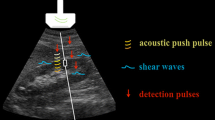Abstract
Objectives
Acoustic radiation force impulse (ARFI) quantification estimates tissue elasticity by measuring shear-wave velocity (SWV) and has been applied to various organs. We evaluated the impact of variations in the transducer force applied to the skin on the SWV ultrasound measurements in kidney transplant cortex and ARFI’s ability to detect fibrosis in kidney transplants.
Methods
SWV measurements were performed in the cortex of 31 patients with kidney allografts referred for surveillance biopsies. A mechanical device held the transducer and applied forces were equal to a compression weight of 22, 275, 490, 975, 2,040 and 2,990 g.
Results
SWV group means were significantly different by repeat measures ANOVA [F(2.85,85.91) = 84.75, P < 0.0005 for 22, 275, 490, 975 and 2,040 g compression weight] and also by pairwise comparisons. Biopsy specimens were sufficient for histological evaluation in 29 of 31 patients. Twelve had grade 0, 11 grade 1, five grade 2 and one grade 3 fibrosis. One-way ANOVA showed no difference in SWV performed with any of the applied transducer forces between grafts with various degrees of fibrosis.
Conclusion
SWV measurements in kidney transplants are dependent on the applied transducer force and do not differ in grafts with different grades of fibrosis.
Key Points
• Acoustic radiation force impulses (ARFI) can quantify tissue elasticity during ultrasound examinations.
• Elasticity estimated by ARFI in kidney transplants depends on applied transducer force.
• ARFI quantification cannot detect renal allograft fibrosis.
• ARFI elasticity estimates may in general vary with applied transducer force.




Similar content being viewed by others
Abbreviations
- ARFI:
-
acoustic radiation force impulse
- IF:
-
interstitial fibrosis
- ROI:
-
region of interest
- SWV:
-
shear-wave velocity
- TE:
-
transient elastography
- US:
-
ultrasound
References
Lupsor M, Badea R, Stefanescu H et al (2009) Performance of a new elastographic method (ARFI technology) compared to unidimensional transient elastography in the noninvasive assessment of chronic hepatitis C. Preliminary results. J Gastrointestin Liver Dis 18:303–310
Palmeri ML, Wang MH, Dahl JJ, Frinkley KD, Nightingale KR (2008) Quantifying hepatic shear modulus in vivo using acoustic radiation force. Ultrasound Med Biol 34:546–558
Boursier J, Isselin G, Fouchard-Hubert I et al (2010) Acoustic radiation force impulse: a new ultrasonographic technology for the widespread noninvasive diagnosis of liver fibrosis. Eur J Gastroenterol Hepatol 22:1074–1084
Garra BS (2007) Imaging and estimation of tissue elasticity by ultrasound. Ultrasound Q 23:255–268
Syversveen T, Brabrand K, Midtvedt K et al (2011) Assessment of renal allograft fibrosis by acoustic radiation force impulse quantification–a pilot study. Transpl Int 24:100–105
Stock KF, Klein BS, Vo Cong MT et al (2010) ARFI-based tissue elasticity quantification in comparison to histology for the diagnosis of renal transplant fibrosis. Clin Hemorheol Microcirc 46:139–148
Toshima T, Shirabe K, Takeishi K et al (2011) New method for assessing liver fibrosis based on acoustic radiation force impulse: a special reference to the difference between right and left liver. J Gastroenterol 46:705–711
Boman K, Olofsson M, Forsberg J, Bostrom SA (2009) Remote-controlled robotic arm for real-time echocardiography: the diagnostic future for patients in rural areas? Telemed J E Health 15:142–147
Salcudean S, Bell G, Bachmann S, Zhu W, Abolmaesumi P, Lawrence P (1999) Robot-assisted diagnostic ultrasound − design and feasibility experiments. In: Taylor C, Colchester A (eds) Medical image computing and computer-assisted intervention (lecture notes in computer science). Springer, Berlin, pp 1062–1071
Goldberg RP, Dumitru M, Taylor RH, Stoianovici D (2001) A modular robotic system for ultrasound image aquisition. In: Niessen W, Viergraver M (eds) Lecture notes in computer science, vol 2208. Springer-Verlag, Berlin, pp 1430–1432
Tozaki M, Isobe S, Fukuma E (2011) Preliminary study of ultrasonographic tissue quantification of the breast using the acoustic radiation force impulse (ARFI) technology. Eur J Radiol 80:e182–e187
Racusen LC, Solez K, Colvin RB et al (1999) The Banff 97 working classification of renal allograft pathology. Kidney Int 55:713–723
Wells PN, Liang HD (2011) Medical ultrasound: imaging of soft tissue strain and elasticity. J R Soc Interface 8:1521–1549
Arndt R, Schmidt S, Loddenkemper C et al (2010) Noninvasive evaluation of renal allograft fibrosis by transient elastography–a pilot study. Transpl Int 23:871–877
Nankivell BJ, Borrows RJ, Fung CL, O'Connell PJ, Allen RD, Chapman JR (2003) The natural history of chronic allograft nephropathy. N Engl J Med 349:2326–2333
Friedrich-Rust M, Romenski O, Meyer G et al (2012) Acoustic radiation force impulse-imaging for the evaluation of the thyroid gland: a limited patient feasibility study. Ultrasonics 52:69–74
Meng W, Zhang G, Wu C, Wu G, Song Y, Lu Z (2011) Preliminary results of acoustic radiation force impulse (ARFI) ultrasound imaging of breast lesions. Ultrasound Med Biol 37:1436–1443
Author information
Authors and Affiliations
Corresponding author
Rights and permissions
About this article
Cite this article
Syversveen, T., Midtvedt, K., Berstad, A.E. et al. Tissue elasticity estimated by acoustic radiation force impulse quantification depends on the applied transducer force: an experimental study in kidney transplant patients. Eur Radiol 22, 2130–2137 (2012). https://doi.org/10.1007/s00330-012-2476-4
Received:
Revised:
Accepted:
Published:
Issue Date:
DOI: https://doi.org/10.1007/s00330-012-2476-4




